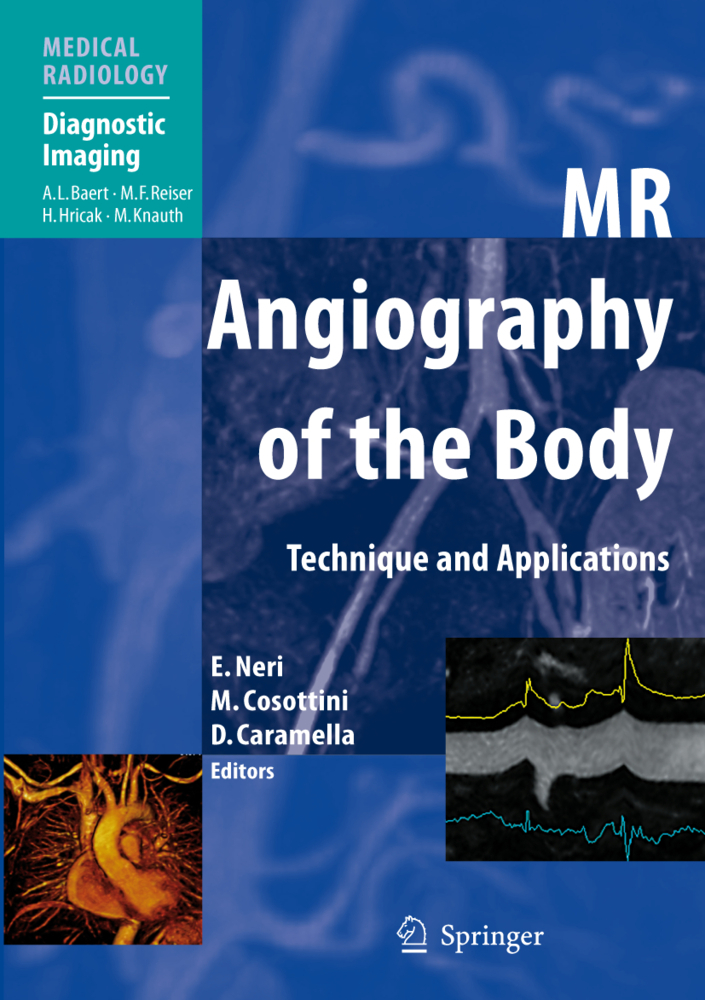MR Angiography of the Body
Magnetic resonance angiography (MRA) continues to undergo exciting technological advances that are rapidly being translated into clinical practice. It also has evident advantages over other imaging modalities, including CT angiography and ultrasonography. With the aid of numerous high-quality illustrations, this book reviews the current role of MRA of the body. It is divided into three sections. The first section is devoted to issues relating to image acquisition technique and sequences, which are explored in depth. The second and principal section addresses the clinical applications of MRA in various parts of the body, including the neck vessels, the spine, the thoracic aorta and pulmonary vessels, the heart and coronary arteries, the abdominal aorta and renal arteries, and peripheral vessels. The final section considers the role of MRA in patients undergoing liver or pancreas and kidney transplantation. This book will be an invaluable aid to all radiologists who work with MRA.
1;Copyright Page;4 2;Foreword;5 3;Preface;6 4;Contents;7 5;Part I: Image Acquisition Technique and Sequences;9 5.1;Chapter 1;10 5.1.1;Flo-Based MRA;10 5.1.1.1;1.1 Time of Flight (TOF) MR Angiography;11 5.1.1.2;1.2 Phase Contrast (PC) MR Angiography;11 5.1.1.3;1.3 T2-Based MR Angiography;12 5.1.1.4;References;12 5.2;Chapter 2;14 5.2.1;MR Angiography Contrast Agents;14 5.2.1.1;2.1 Magnetic Properties;14 5.2.1.2;2.2 Relaxivity;15 5.2.1.2.1;2.2.1 Paramagnetic Contrast Agents;15 5.2.1.2.2;2.2.2 Superparamagnetic and Ferromagnetic Contrast Agents;15 5.2.1.3;2.3 Susceptibility Effect;16 5.2.1.4;2.4 Contrast Agents for Vascular Imaging;16 5.2.1.4.1;2.4.1 Paramagnetic Gadolinium Agents;16 5.2.1.4.1.1;2.4.1.1 Extracellular Fluid Agents;16 5.2.1.4.1.2;2.4.1.2 Blood-Pool Agents;18 5.2.1.4.2;2.4.2 Superparamagnetic Ultrasmall Iron Oxide Particles;20 5.2.1.5;2.5 Safety;21 5.2.1.6;2.6 Future Perspectives;22 5.2.1.6.1;2.6.1 Contrast Agent Use at High Field;22 5.2.1.6.2;2.6.2 Other Contrast Agents;22 5.2.1.6.2.1;2.6.2.1 Gadolinium-Based Particulate Agents;22 5.2.1.6.2.2;2.6.2.2 Hyperpolarized Contrast Agents;22 5.2.1.6.2.3;2.6.2.3 Chemical Exchange Saturation Transfer (CEST);22 5.2.1.7;References;23 5.3;Chapter 3;24 5.3.1;Image Acquistion Technique and Sequences Contrast-Enhanced MRA;24 5.3.1.1;3.1 Introduction;25 5.3.1.2;3.2 Basic Principle of CE-MRA;25 5.3.1.3;3.3 Contrast Administration Strategy;26 5.3.1.4;3.4 Imaging and Acquisition Technique;26 5.3.1.4.1;3.4.1 Fast 3D Gradient Echo Sequences and Acquisition Technique;26 5.3.1.4.2;3.4.2 Parallel Imaging;28 5.3.1.4.3;3.4.3 Time-Resolved CE-MRA;28 5.3.1.4.4;3.4.4 Steady-State Imaging;28 5.3.1.5;3.5 k-Space Filling Strategies;30 5.3.1.6;3.6 Conclusions;32 5.3.1.7;References;32 5.4;Chapter 4;33 5.4.1;Artifacts in MR-Angiography;33 5.4.1.1;4.1 Introduction;33 5.4.1.2;4.2 Classifi cation;34 5.4.1.3;4.3 Radiofrequency Artifacts;34 5.4.1.4;4.4 Flow Artifacts;34 5.4.1.4.1;4.4.1 Turbulence's Artifact;34 5.4.1.4.2;4.4.2 The Artifact Due to Saturation;35 5.4.1.5;4.5 Hinge Artifact;35 5.4.1.6;4.6 Geometric Artifacts;36 5.4.1.6.1;4.6.1 The Hypointensity Linear Horizontal Artifact;36 5.4.1.6.2;4.6.2 The Artifact Due to Noninclusion of the Vase in the Excited Volume;36 5.4.1.7;4.7 Magnetic Susceptibility Artifacts;36 5.4.1.8;4.8 Maki Artifact;37 5.4.1.9;4.9 Vascular Blurring;37 5.4.1.10;4.10 Patient Artifacts;37 5.4.1.11;4.11 Artifacts from Postprocessing;38 5.4.1.11.1;4.11.1 The Artifact Due to Projection of Background Noise;38 5.4.1.11.2;4.11.2 Step Artifact;39 5.4.1.12;References;39 5.5;Chapter 5;40 5.5.1;Image Processing;40 5.5.1.1;5.1 Introduction;40 5.5.1.2;5.2 Multiplanar Reformation (MPR);40 5.5.1.3;5.3 Maximun Intensity Projection (MIP);42 5.5.1.4;5.4 Shaded Surface Display (SSD);44 5.5.1.5;5.5 Volume Rendering (VR);45 5.5.1.6;5.6 Virtual Endoscopy (VE);46 5.5.1.7;References;48 6;Part II: Clinical Applications;50 6.1;Chapter 6;51 6.1.1;Radiologic Vascular Anatomy;51 6.1.1.1;6.1 The Arteries;51 6.1.1.1.1;6.1.1 The Arteries of the Head, Neck, and Thorax;52 6.1.1.1.1.1;6.1.1.1 The Thoracic Aorta;52 6.1.1.1.1.1.1;Visceral Branches;56 6.1.1.1.1.1.2;Parietal Branches;56 6.1.1.1.1.2;6.1.1.2 The Pulmonary Arterles;56 6.1.1.1.2;6.1.2 The Abdominal Arteries;57 6.1.1.1.2.1;6.1.2.1 Visceral Branches;57 6.1.1.1.2.2;6.1.2.2 Parietal Branches;60 6.1.1.1.2.3;6.1.2.3 Terminal Branches;60 6.1.1.1.3;6.1.3 The Arteries of the Limb;61 6.1.1.1.4;6.1.3.1 Upper Limp;61 6.1.1.1.5;6.1.3.2 Lower Limb;63 6.1.1.1.5.1;The Femoral Artery;63 6.1.1.1.5.2;The Profunda Femoris Artery;63 6.1.1.1.5.3;The Popllteal Artery;64 6.1.1.1.5.4;The Anterior Tibial Artery;65 6.1.1.1.5.5;The Posterior Tibial Artery;65 6.1.1.1.5.6;The Peroneal Artery;65 6.1.1.2;6.2 The Veins;66 6.1.1.3;6.2.1 Veins of the Head, Neck, and Thorax;67 6.1.1.3.1;6.2.1.1 The Superior Vena Cava;67 6.1.1.3.2;6.2.1.2 The Pulmonary Veins;69 6.1.1.3.3;6.2.1.3 The Veins of the Heart;69 6.1.1.4;6.2.2 The Veins of the Abdomen and Pelvis;69 6.1.1.4.1;6.2.2.1 The Portal System
Neri, Emanuele
Cosottini, Mirco
Caramella, Davide
| ISBN | 9783540797173 |
|---|---|
| Artikelnummer | 9783540797173 |
| Medientyp | E-Book - PDF |
| Copyrightjahr | 2009 |
| Verlag | Springer-Verlag |
| Umfang | 181 Seiten |
| Kopierschutz | Digitales Wasserzeichen |

